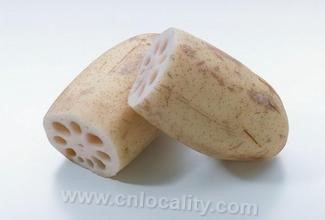welcomeSpecialty Foods Products!

"Lotus root melon melon" refers to lotus root, commonly known as lotus root. Although it is impossible to verify the planting age of lotus root in Jinci area, according to the author's judgment, it should be in Song Dynasty at the latest. Fan Zhongyan, a famous writer in the Song Dynasty, has been to Jinci and wrote a poem titled "Titling Jinci", in which two sentences are "Thousands of people irrigate rice and rice, and there are red fragrant fields everywhere" (otherwise known as "Jiangnan fields"). According to the crop planting situation near Jinci, the "red fragrant fields" in the poem probably refers to the lotus pond where lotus flowers are in full bloom. Since it can reach the realm of "everywhere", we can see the planting area at that time. According to the folklore around Jinci, the lotus root in Jinci was originally introduced from the south by a monk in the temple. First, it was planted in the lotus pond in the temple. Later, it was found that the new lotus root had the effect of "shine on you is better than blue", so it was greatly promoted near Jinci. According to historical records, most of the temples in Jinci Temple, such as Tang Shuyu Temple and Notre Dame Temple, were founded in the Tiansheng period of the Song Dynasty. Since there are temples, there are monks, so the folklore of "monks planting lotus roots" has its credibility. As for the situation of planting lotus roots at that time, most of them were concentrated in Nanda Temple and Beidasi Village near Jinci, but there was a lack of specific historical records. In the Qing Dynasty, Yang Erxi, a famous legalist secretary of Taiyuan, wrote a poem "Lotus Wind in the Great Temple", in which it said: "... before entering the lotus country, smell the fragrance of the water first ... the lotus village is so beautiful that it is really a lotus village." This is the poet's true description of the lotus root planting situation in the south and north temples of Jinci. The "lotus melon" in the Four Treasures of Jinci, which was mentioned by later generations, is the product of the two villages of Nanda Temple and Beida Temple. It is said that the lotus root stems of Dasi produced here are straight and thick, and the silk is more than a foot long after being cut, and the cold dishes made can be kept for seven or eight days, and their color and fragrance remain unchanged. Therefore, merchants from all over Shanxi have to come to Jinci to purchase lotus roots and sell them to this province, Hebei, Inner Mongolia and other places on holidays.
Reprinted with attribution:
https://cnlocality.com/(Chinese Specialty Products)
other
consult:(+86)13225231905